Solutions for Materials Preparation
Find out how to perform materialographic analysis quickly and accurately on different materials in our material application notes.
In each application note, you learn:
- How to perform accurate and reproducible materialographic preparation
- How to overcome specific materialographic challenges
- How to perform and interpret structure microscopy analysis

















